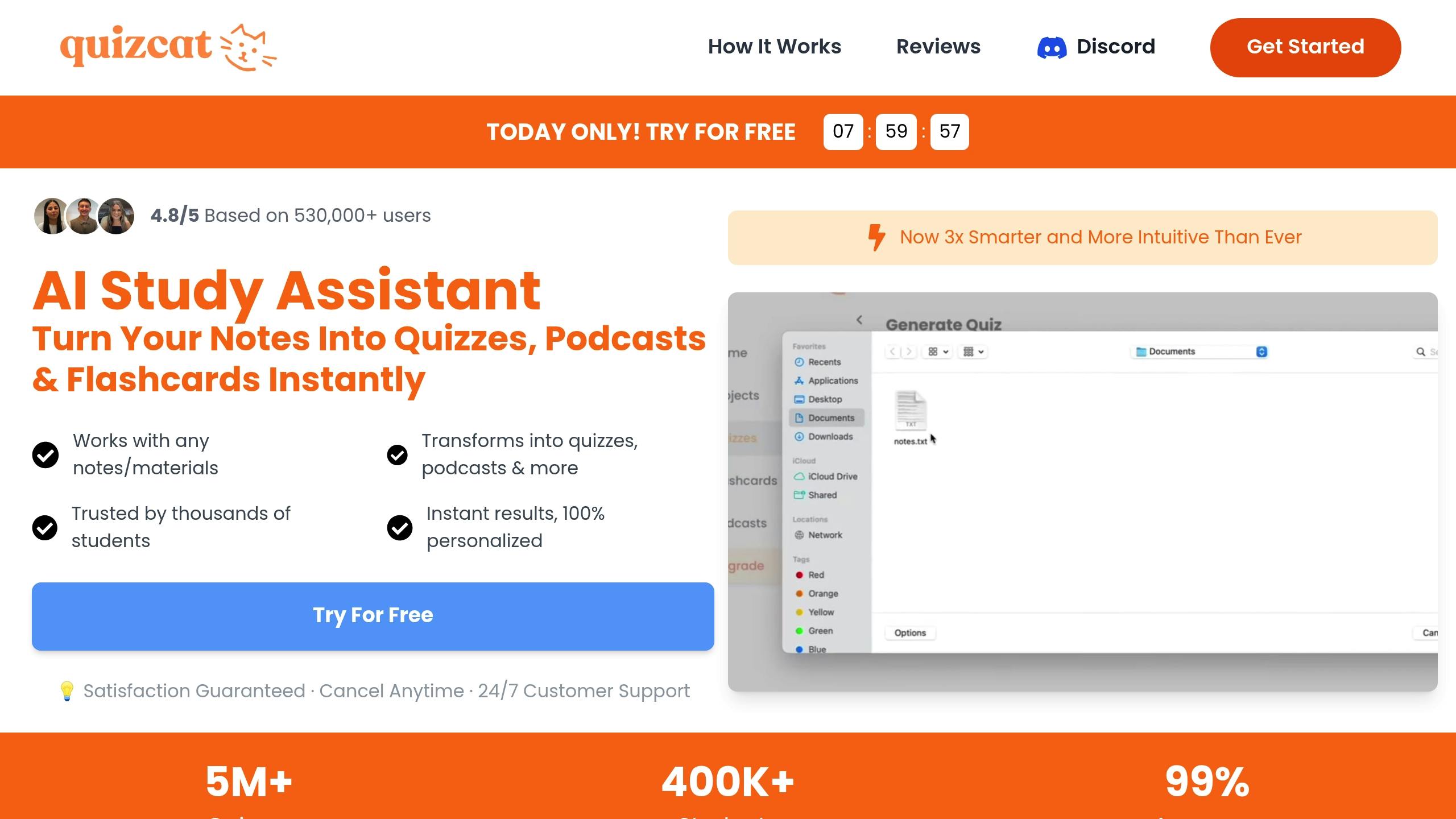
Ethics of Predictive Analytics in Education
Predictive analytics in education uses data to forecast student outcomes, identify those needing support, and improve resource allocation. While it offers benefits like early intervention and efficient resource management, it raises ethical concerns around privacy, bias, and transparency. Schools must:
- Protect student data: Encrypt information, limit access, and ensure informed consent.
- Address bias: Regularly review algorithms to avoid unfair outcomes.
- Ensure transparency: Clearly communicate how predictions are made and used.
Balancing student success with autonomy and ethical responsibilities is key. Institutions should establish ethical guidelines, train staff, and create review boards to oversee practices. Tools like QuizCat AI show how AI can enhance learning while prioritizing data privacy and fairness.
Ethical Considerations in Predictive Analytics
Main Ethical Issues in Educational Analytics
Predictive analytics can provide valuable insights but also raises ethical concerns around privacy, fairness, and autonomy.
Student Data Protection
Protecting student data is a top priority. While the Family Educational Rights and Privacy Act (FERPA) sets the legal foundation, schools must take additional steps to safeguard information from misuse or unauthorized access.
Here are some key measures:
- Encrypt data during storage and transmission to prevent breaches.
- Limit access by implementing strict controls and conducting regular audits.
- Set clear retention policies to determine how long data is kept.
- Obtain informed consent to ensure permissions are properly secured.
Bias in Prediction Models
Protecting data is just one part of the equation. Predictive models need to avoid reinforcing existing inequalities. Algorithms can unintentionally skew decisions about student opportunities and support, leading to unfair outcomes.
Common sources of bias include:
- Historical data bias: When past discrimination carries over into predictions.
- Demographic skew: When models work better for some student groups than others.
- Input variable bias: When certain data points unfairly influence outcomes.
- Sampling bias: When the data used to train models doesn't represent all student groups.
To address these issues, schools should regularly review their models for fairness and make adjustments to ensure balanced treatment for all students.
Clear Communication and Responsibility
Transparency is critical when it comes to how data is used. Schools need to define clear policies covering:
- Who makes decisions based on predictions.
- How students can challenge automated recommendations.
- What data influences predictions.
- How predictive insights are applied.
Students and parents should be informed about:
- What data is collected and why.
- How their information is used.
- Their rights to access and correct data.
- The limitations of predictive models.
Managing Benefits and Risks
When addressing ethical challenges in predictive analytics, institutions must carefully weigh the advantages against potential risks. Maintaining a careful balance requires consistent oversight. The following sections explore how this balance plays out for both individuals and organizations.
Student Success vs. Personal Choice
Schools aim to use data to improve learning outcomes while respecting students' autonomy. Here's how they can strike that balance:
- Provide opt-out options and clear feedback channels for data collection and predictive tools.
- When sharing predictive insights, explain the factors driving those insights and emphasize they are recommendations, not mandates.
- Offer students regular opportunities to take an active role in shaping their educational journey.
School Performance vs. Ethics
While respecting individual autonomy is essential, institutions also need to ensure their performance metrics align with ethical principles. This can be achieved by:
- Conducting ethical audits to assess the implementation and impact of predictive analytics.
- Aligning performance metrics with ethical values to avoid conflicts.
- Involving all stakeholders to ensure ethics and performance goals are on the same page.
Here’s a breakdown of how schools can balance performance objectives with ethical responsibilities:
| Performance Goal | Ethical Consideration | Balanced Approach |
|---|---|---|
| Improve graduation rates | Avoid pressuring struggling students | Offer tailored support while providing diverse pathways to success. |
| Increase enrollment | Prevent discriminatory targeting | Use demographic-blind methods and conduct equity checks. |
| Optimize resource allocation | Ensure fair distribution | Combine predictive insights with a needs-based approach to ensure fairness. |
| Track attendance patterns | Respect student privacy | Restrict tracking to academic data that is absolutely necessary. |
sbb-itb-1e479da
Setting Up Ethical Guidelines
Schools need to establish clear ethical guidelines to address the risks associated with predictive analytics.
Creating School Policies
Schools should create policies that outline how student data is collected, stored, analyzed, and used. These policies should include:
- Data minimization: Only gather the data that's absolutely necessary.
- Transparency: Clearly document how analytics influence decision-making.
- Access controls: Define who can access and use student data.
- Retention schedules: Specify how long data will be stored.
- Consent management: Clearly outline and document permissions for predictive analytics.
Staff Education on Ethics
Training staff on the ethical use of predictive analytics is essential, and it should focus on practical, real-world scenarios.
-
Data Privacy Basics
Staff need to understand federal laws like FERPA and state-specific privacy regulations. They should be trained on handling personally identifiable information (PII) and maintaining confidentiality when discussing student predictions. -
Recognizing Bias
Training should help staff identify and address bias in areas such as:- Data collection methods
- Algorithm design
- How results are interpreted
- How interventions are applied
-
Ethical Decision-Making
Staff should learn how to balance competing interests when applying predictive insights. This includes knowing when to override system recommendations to better serve individual student needs.
With proper training, schools can implement ongoing oversight through dedicated review boards.
Setting Up Review Boards
Review boards play a critical role in ensuring compliance with ethical policies and addressing new challenges as they arise.
Who Should Be on the Board?
The board should include a mix of perspectives, such as:
- Data privacy experts
- Educational technology specialists
- Student advocates
- Faculty members
- Administrative staff
- Parent representatives
What Does the Board Do?
| Area | Tasks | Review Frequency |
|---|---|---|
| Policy Compliance | Ensure adherence to ethical guidelines | Monthly |
| Algorithm Review | Check predictive models for fairness and bias | Quarterly |
| Impact Assessment | Assess effects on student outcomes and well-being | Each semester |
| Stakeholder Feedback | Gather and address concerns from students/parents | Ongoing |
The review board should meet regularly to:
- Evaluate new analytics tools and how they're used.
- Investigate and address ethical concerns.
- Update guidelines to reflect best practices.
- Continuously improve ethical standards.
Regular audits are also necessary to assess both technical performance and the ethical impact of predictive systems. This includes analyzing outcomes to ensure there are no unintended negative effects on specific student groups.
AI Tools in Education Analytics
Educational institutions are increasingly using AI tools to enhance learning outcomes while prioritizing data privacy. A good example is QuizCat AI, which integrates strong ethical measures into its operations.
QuizCat AI: Ethical AI Learning Tools

QuizCat AI strikes a balance between personalized learning and strict data protection. It transforms study materials into interactive formats like quizzes, flashcards, and podcasts, all while using secure encryption to protect user data. Its design aligns with stringent data privacy standards, ensuring both functionality and security.
Some standout features include:
- Secure data encryption to protect study materials
- Support for multiple file formats like PDF, DOCX, and TXT, making it easy to use across different platforms
With over 400,000 students relying on it, QuizCat AI uses advanced AI to create tailored study resources instantly, all while upholding ethical practices. Its transparent pricing model and commitment to privacy make it an example of how AI tools can enhance education without compromising security or trust.
Conclusion: Future of Educational Analytics
Key Takeaways
The responsible use of predictive analytics in education requires strong data security and addressing potential biases. Protecting student data is critical, and institutions must implement reliable security systems to ensure privacy. Efforts to identify and reduce bias in AI models are equally important to deliver fair outcomes for all student groups.
Emerging trends in ethical AI, such as tools like QuizCat AI, highlight how personalized learning can coexist with strict data privacy measures. These examples provide a roadmap for future advancements in educational analytics.
Looking Ahead
Educational analytics is heading toward tighter regulations and standardized practices. To prepare for this, institutions should focus on:
- Creating clear data governance policies for managing student information
- Performing regular ethical reviews to ensure fairness and accuracy
- Providing thorough training for staff on ethical AI usage
The rise of explainable AI will play a crucial role, as it allows systems to clearly outline how predictions are made. This level of transparency will be key to maintaining trust between schools and their communities.
